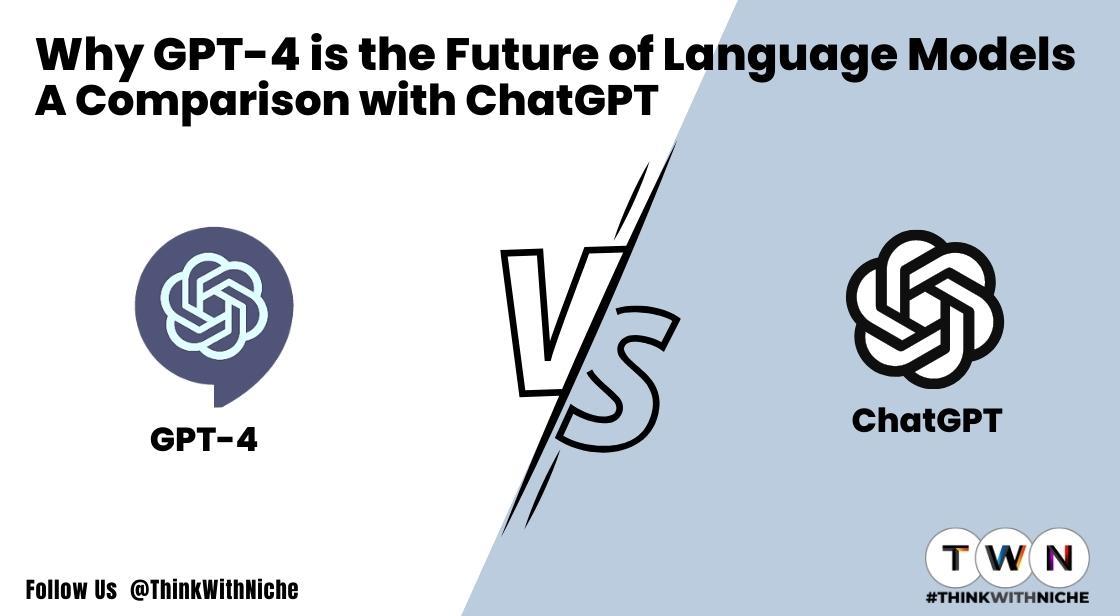Why GPT-4 is The Future of Language Models-A Comparison with ChatGPT

Blog Post
Explore why GPT-4 is the future of language models in our informative blog. We compare GPT-4 with ChatGPT, examining their architectures, features, and limitations.
Discover how GPT-4's increased accuracy and advanced language processing capabilities give it an edge over ChatGPT, making it more efficient and better equipped to handle complex tasks.
We also discuss potential applications in industries such as healthcare, finance, and marketing, as well as potential limitations and ethical concerns.
Join us as we delve into the future of language models and their impact on the job market.
ThhinkWithNiche Blog Title: Why GPT-4 is the Future of Language Models- A Comparison with ChatGPT; is well explaimed to our readers with the following Blog Outline::
I. Introduction
A. Explanation of language models
B. Brief overview of GPT-4 and ChatGPT
C. Thesis statement
II. Overview of GPT-4
A. Description of the GPT-4 architecture
B. New features and improvements
C. Comparison with GPT-3
III. Overview of ChatGPT
A. Description of the ChatGPT architecture
B. Advantages and limitations
C. Comparison with GPT-3
IV. Advantages of GPT-4 over ChatGPT
A. Increased accuracy and efficiency
B. More advanced language processing capabilities
C. Enhanced ability to handle complex tasks
V. Potential Applications of GPT-4
A. Improving human-machine interaction
B. Advancements in healthcare and education
C. Impact on industries such as finance, legal, and marketing
VI. Future of GPT-4
A. Potential limitations and ethical concerns
B. Potential impact on the job market
C. Importance of continued research and development
VII. Conclusion
A. Recap of the main points
B. Final thoughts on the future of language models.
I. Introduction
A. Explanation of language models
Language models are a type of artificial intelligence (AI) technology that is designed to process natural language.
Natural language refers to the language that people use to communicate with each other, such as English, Spanish, or French.
Language models use machine learning algorithms to analyze patterns and relationships within language, allowing them to understand and generate text.
B. Brief overview of GPT-4 and ChatGPT
GPT-4 is an upcoming language model from OpenAI, the company behind the GPT series of language models.
ChatGPT, on the other hand, is a language model created by OpenAI that is specifically designed for conversational purposes, such as chatbots or customer service interactions.
C. Thesis statement
While ChatGPT has been a significant breakthrough in language processing technology, the upcoming release of GPT-4 promises to revolutionize the field of natural language processing even further.
II. Overview of GPT-4
A. Description of the GPT-4 architecture
GPT-4 is expected to be a transformer-based language model, similar to its predecessors GPT-2 and GPT-3.
However, it is likely to be even larger and more complex, with significantly more parameters than GPT-3's 175 billion parameters.
B. New features and improvements
One of the main improvements expected in GPT-4 is its ability to perform multilingual language processing. GPT-4 is expected to be able to process and generate text in multiple languages simultaneously, allowing for more efficient and accurate translations.
Another key improvement is GPT-4's ability to generate more coherent and contextually relevant text.
This will be achieved through enhanced training techniques and the incorporation of additional data sources.
C. Comparison with GPT-3
While GPT-3 is an incredibly powerful language model, there are still areas where it can be improved.
GPT-3 struggles with context and coherence, particularly when it comes to generating longer pieces of text.
GPT-4 is expected to address these limitations, as well as improve overall accuracy and efficiency.
III. Overview of ChatGPT
A. Description of the ChatGPT architecture
ChatGPT is a transformer-based language model that is specifically designed for conversational purposes.
It has been trained on a large dataset of conversational data, allowing it to generate text that is contextually relevant and appropriate for the given conversation.
B. Advantages and limitations
One of the main advantages of ChatGPT is its ability to generate text that is appropriate for specific conversational contexts.
This makes it particularly useful for chatbots and customer service interactions.
However, ChatGPT is not without its limitations. Like other language models, it can struggle with context and coherence, particularly when it comes to generating longer pieces of text.
Additionally, because it is specifically designed for conversational purposes, it may not be as useful for other types of language processing tasks.
C. Comparison with GPT-3
While GPT-3 is a more general-purpose language model, it is still capable of performing conversational tasks. However, it may not be as effective as ChatGPT for these types of tasks, as it has not been specifically trained on conversational data.
IV. Advantages of GPT-4 over ChatGPT
A. Increased accuracy and efficiency
One of the major advantages of GPT-4 over ChatGPT is increased accuracy and efficiency. GPT-4 is expected to have a larger and more diverse training data set than ChatGPT, which would allow it to generate more accurate and realistic language output.
This means that GPT-4 would be able to produce more relevant and meaningful responses to a wider range of prompts.
In addition, GPT-4 is expected to have faster training times and higher inference speeds than ChatGPT, which would make it more efficient for real-world applications.
This means that GPT-4 would be able to process larger amounts of data more quickly, resulting in faster turn around times and increased productivity.
B. More advanced language processing capabilities
GPT-4 is expected to have more advanced language processing capabilities than ChatGPT. For example, GPT-4 is expected to have better language understanding, which means that it would be able to better understand the context of a sentence and generate more accurate responses.
In addition, GPT-4 is expected to have improved language generation capabilities, which means that it would be able to produce more fluent and natural-sounding language output.
GPT-4 is also expected to have improved handling of long-term dependencies, which means that it would be able to better recognize and process relationships between words or phrases that are separated by longer distances in a text. This would result in more coherent and meaningful language output.
C. Enhanced ability to handle complex tasks
GPT-4 is expected to have an enhanced ability to handle complex tasks compared to ChatGPT.
This is due to the fact that GPT-4 is expected to have a larger and more diverse training data set, as well as more advanced language processing capabilities.
As a result, GPT-4 would be able to better understand and generate language output for complex tasks such as summarization, translation, and question-answering.
For example, GPT-4 would be able to generate more accurate and concise summaries of longer texts, translate between languages with greater accuracy, and answer questions with more precision and relevance.
V. Potential Applications of GPT-4
A. Improving human-machine interaction
GPT-4 has the potential to significantly improve human-machine interaction. With its advanced language processing capabilities, GPT-4 could be used to develop more sophisticated chatbots and virtual assistants that are better able to understand and respond to natural language input.
This would enable more efficient and effective communication between humans and machines, resulting in improved work efficiency and productivity.
B. Advancements in healthcare and education
GPT-4 could also have a significant impact on the healthcare and education industries.
With its enhanced ability to handle complex tasks, GPT-4 could be used to develop more advanced natural language processing tools for medical diagnosis and education. For example, GPT-4 could be used to analyze medical records and generate more accurate diagnoses or treatment recommendations, or to develop more sophisticated educational tools that adapt to individual learning styles and preferences.
C. Impact on industries such as finance, legal, and marketing
GPT-4 could also have a significant impact on industries such as finance, legal, and marketing. With its advanced language processing capabilities, GPT-4 could be used to develop more sophisticated natural language processing tools for tasks such as document analysis, contract review, and sentiment analysis.
This would enable more efficient and effective decision-making and result in improved business outcomes.
VI. Future of GPT-4
A. Potential limitations and ethical concerns
While GPT-4 promises to bring many advancements in language processing capabilities, it also raises some ethical concerns.
One of the primary concerns is the potential misuse of the technology, which can lead to the creation of biased language models.
To prevent such issues, researchers and developers will need to incorporate ethical considerations throughout the development process. Another concern is the potential for the development of more advanced AI systems that may become so sophisticated that they may be beyond human control.
Such concerns are not limited to GPT-4 but apply to all advanced AI systems.
To mitigate these concerns, researchers and developers will need to incorporate safety mechanisms that prevent such systems from causing harm to human beings.
B. Potential impact on the job market
As language models continue to improve and become more sophisticated, they have the potential to disrupt various industries and impact the job market.
For example, GPT-4 could lead to the automation of many jobs that require human language processing capabilities, such as customer service representatives, translators, and content writers.
On the other hand, GPT-4 can also create new job opportunities, such as machine learning engineers and AI ethicists.
C. Importance of continued research and development
The development of GPT-4 represents a significant milestone in the field of natural language processing and artificial intelligence. However, there is still a long way to go in terms of achieving human-level language processing capabilities.
Continued research and development are necessary to achieve this goal and ensure that AI systems are safe and ethical.
Research in areas such as explainable AI and robustness testing is necessary to ensure that GPT-4 and other advanced AI systems can be trusted and do not cause harm.
Additionally, research in areas such as interpretability and bias mitigation will be essential to ensure that these systems are transparent and unbiased.
VII. Conclusion
GPT-4 is set to revolutionize the field of natural language processing and artificial intelligence. Compared to ChatGPT, it promises increased accuracy and efficiency, more advanced language processing capabilities, and an enhanced ability to handle complex tasks.
Potential applications of GPT-4 include improving human-machine interaction, advancements in healthcare and education, and impact on industries such as finance, legal, and marketing.
However, the development of GPT-4 also raises concerns about potential ethical issues and the impact on the job market.
Continued research and development will be necessary to address these concerns and ensure that GPT-4 and other advanced AI systems are safe, ethical, and transparent.
As such, researchers and developers must incorporate ethical considerations throughout the development process and work to ensure that these systems do not cause harm.
Important Tags for The Blog Post:
Future of GPT-4
Overview of GPT-4
Overview of ChatGPT
Potential Applications of GPT-4
Advantages of GPT-4 over ChatGPT
You May Like
EDITOR’S CHOICE












